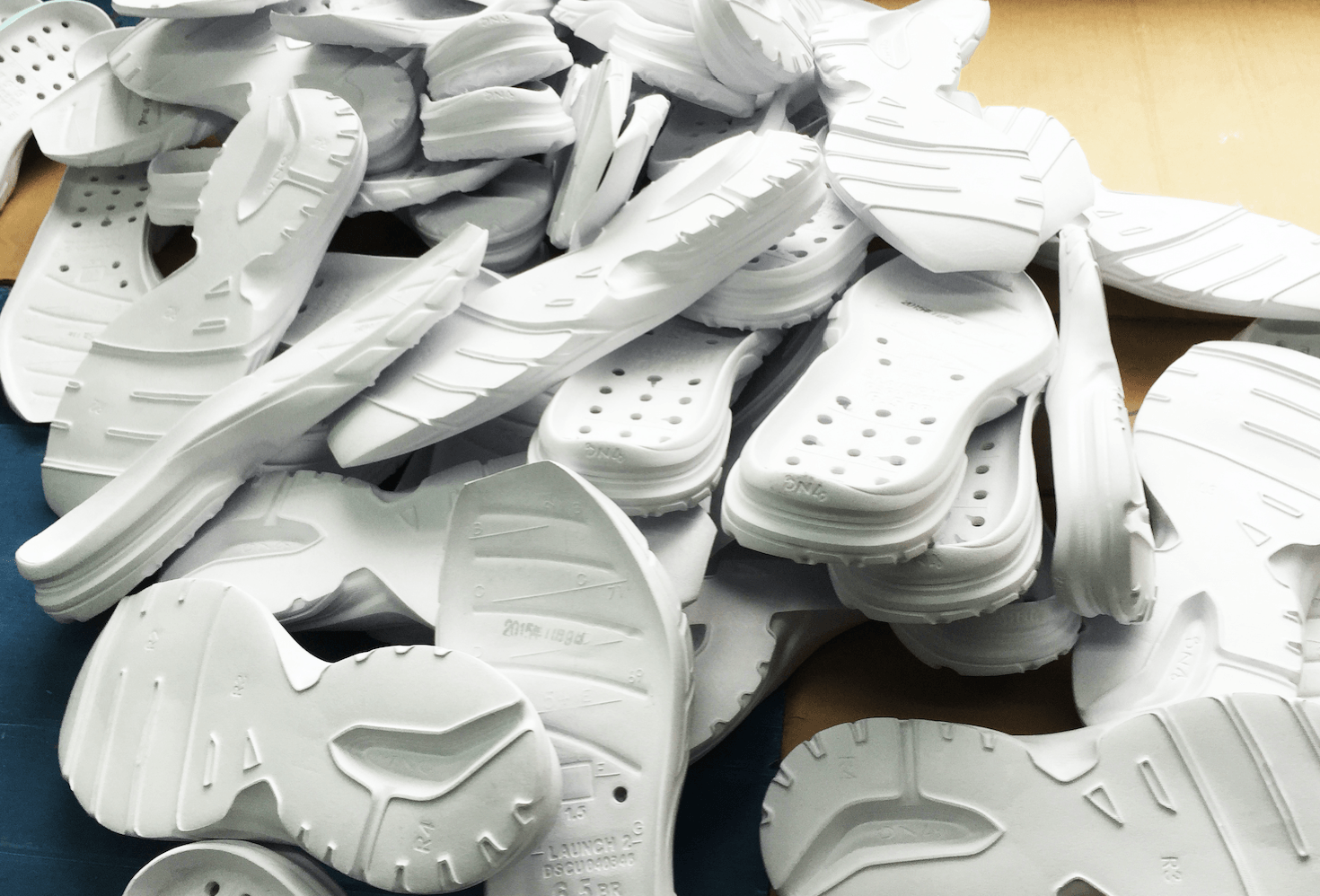Shoe Materials: EVA Midsoles
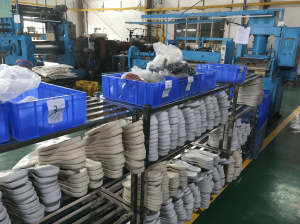 EVA midsoles are the most common cushioning materials in modern sports shoes. Used to make running shoes, basketball shoes, and almost any other sports shoe, EVA is lightweight, resists compression set, forms easily, and is available in nearly every color. EVA is now the most widely used midsole material for shoes. Die-cut EVA can be found inside the cheapest discount sneaker, while molded EVA can be found in $200.00 high-end basketball shoes.
EVA midsoles are the most common cushioning materials in modern sports shoes. Used to make running shoes, basketball shoes, and almost any other sports shoe, EVA is lightweight, resists compression set, forms easily, and is available in nearly every color. EVA is now the most widely used midsole material for shoes. Die-cut EVA can be found inside the cheapest discount sneaker, while molded EVA can be found in $200.00 high-end basketball shoes.
How is EVA foam made
EVA (Ethylene-vinyl acetate) also known as PEVA (poly-ethylene-vinyl acetate), is the copolymer of ethylene and vinyl acetate. When two plastic types join in the same polymer chain, the polymer is called a copolymer. The weight percent of vinyl acetate plastic usually varies from 10% to 40%, with the remainder being ethylene plastic. The amount of vinyl acetate greatly affects the character of the material. Higher quality EVA will have a higher percentage of vinyl acetate while EVA with very little vinyl acetate can be hard, brittle, and feel like cardboard. Ethylene-vinyl acetate is simply a soft plastic, it’s the foaming process or “blowing” of EVA that makes it perfect for a shoe midsole. EVA foaming and “blowing” is the introduction of air bubbles into plastic. In the mixing process, a blowing agent is added to the EVA mixture. Azodicarbonamide is the most common blowing agent in EVA production. When heated, the solid azodicarbonamide breaks down or decomposes into a gas. When trapped inside a semi-liquid plastic EVA compound, the gas expands to create tiny bubbles. The plastic is now foam.Expansion Press or Injection Machine
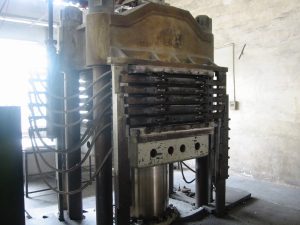 The classic way to foam EVA is to use an expansion press. The EVA compound is mixed into a putty-like consistency then rolled into flat sheets. These sheets are then loaded into square molds about two meters square and 10 cm deep. These molds are stacked in a huge press then heated under pressure. As the EVA heats, it gradually expands to fill the mold. If more raw material is placed into the mold the EVA will be harder, less EVA and more blowing agent will make softer EVA. Once the EVA is cooled the molds are opened, and huge sheets of EVA are released.
The classic way to foam EVA is to use an expansion press. The EVA compound is mixed into a putty-like consistency then rolled into flat sheets. These sheets are then loaded into square molds about two meters square and 10 cm deep. These molds are stacked in a huge press then heated under pressure. As the EVA heats, it gradually expands to fill the mold. If more raw material is placed into the mold the EVA will be harder, less EVA and more blowing agent will make softer EVA. Once the EVA is cooled the molds are opened, and huge sheets of EVA are released. The Ultimate Shoe Material Textbook
Start with an in-depth study of material types available for modern shoemaking. Learn the technical details of material specifications. 195 pages and 300 color photos.
on sale $39.99
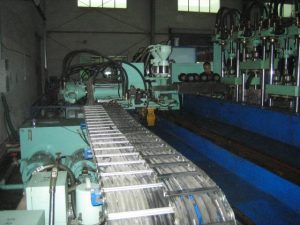 The more modern way to expand EVA is by using an injection machine. Instead of making a large block, this process will make individual sheets. The EVA injection machine is very special. The EVA material is heated inside then pushed under pressure into a mold. This mold is about 50% of the finished part size. The mold is cooled just enough for the EVA skin to solidify. The mold opens by high-speed hydraulic ram in less than 1/4 of a second. With the pressure released, the EVA parts expand like popcorn. POP! This process is very efficient with little waste. When parts pop out of the mold, their sizes will vary. This is how EVA sandals like Crocs™ are made.
The more modern way to expand EVA is by using an injection machine. Instead of making a large block, this process will make individual sheets. The EVA injection machine is very special. The EVA material is heated inside then pushed under pressure into a mold. This mold is about 50% of the finished part size. The mold is cooled just enough for the EVA skin to solidify. The mold opens by high-speed hydraulic ram in less than 1/4 of a second. With the pressure released, the EVA parts expand like popcorn. POP! This process is very efficient with little waste. When parts pop out of the mold, their sizes will vary. This is how EVA sandals like Crocs™ are made.
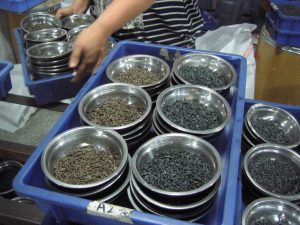 Pellet Expansion
Pellet Expansion
Another way to expand EVA is by pellet expansion. In this process, raw EVA compound in a dry pellet form with azodicarbonamide is loaded into a mold. Like the injection mold process, this mold is also about 50% of the finished size. The mold is mounted on a high-speed press. The mold closes, and the pellets expand inside the cavity. The EVA is held in this critical state for a few minutes as the mold cools. Next, the hydraulic ram opens the mold at high speed and the part “Pops!” into full size. The EVA part is not yet ready to use inside a shoe. It must be reheated and formed into the exact shape.
Once the EVA is expanded into foam, midsoles for shoes and other shoe parts can be formed in one of several ways.
Cold Forming EVA Processing :
Die-cutting: The EVA sheets are cut into shapes and put inside shoes. The solid rubber cupsole for skate shoes will often have pieces of die-cut EVA inside. Cut and Buff: The classic jogger midsole is made by cutting sheets of EVA then buffing edge contours.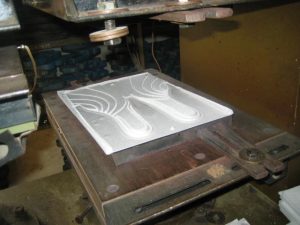 Cold Pressing: This is a funny name for this process because the EVA is actually placed into an oven!
In the cold-press process, sheets of die-cut EVA are placed into an oven and heated until it’s soft and pliable. Then, the hot EVA sheet is placed into a pressing mold that is water-cooled. The cold mold sets the EVA shape. Almost all sport shoe footbeds are made using EVA cold pressing operations. One advantage of cold pressing is the EVA parts can have fabric bonded to the surface, perfect for footbeds.
Cold Pressing: This is a funny name for this process because the EVA is actually placed into an oven!
In the cold-press process, sheets of die-cut EVA are placed into an oven and heated until it’s soft and pliable. Then, the hot EVA sheet is placed into a pressing mold that is water-cooled. The cold mold sets the EVA shape. Almost all sport shoe footbeds are made using EVA cold pressing operations. One advantage of cold pressing is the EVA parts can have fabric bonded to the surface, perfect for footbeds.
Hot Forming EVA Processing:
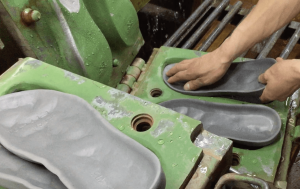 Compression molding: CMEVA or Pylon™ is the most common process to create sport shoe midsoles. Almost all high end running shoes and basketball shoes have compression-molded EVA midsoles. This process begins with a piece of EVA that has already been expanded. This piece can be cut from an expanded foam sheet made by the expansion press method or EVA expanded by the pelleting process, either method is fine. The EVA is placed into a 100% size mold with all the design details and texture added. The mold is closed and loaded into a heated press. Inside the mold, the EVA melts allowing the air bubbles to expand, causing the EVA to fill the mold. The mold is moved to a cooling press, and then the EVA parts can be removed from the mold. These parts only need to have any mold release washed off before they can be used.
Compression molding: CMEVA or Pylon™ is the most common process to create sport shoe midsoles. Almost all high end running shoes and basketball shoes have compression-molded EVA midsoles. This process begins with a piece of EVA that has already been expanded. This piece can be cut from an expanded foam sheet made by the expansion press method or EVA expanded by the pelleting process, either method is fine. The EVA is placed into a 100% size mold with all the design details and texture added. The mold is closed and loaded into a heated press. Inside the mold, the EVA melts allowing the air bubbles to expand, causing the EVA to fill the mold. The mold is moved to a cooling press, and then the EVA parts can be removed from the mold. These parts only need to have any mold release washed off before they can be used.
EVA Specifications :
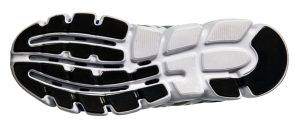 EVA hardness can range from 5˚ to 70˚
The suitable density for an EVA midsole is between 40˚and 65˚. Softer than 40˚will not be stable and will be susceptible to compression set. Higher than 65˚ will not be very comfortable. The standard EVA density for running, basketball, and casual shoes is around 55˚.
EVA density is measured with a durometer tester.
EVA hardness can range from 5˚ to 70˚
The suitable density for an EVA midsole is between 40˚and 65˚. Softer than 40˚will not be stable and will be susceptible to compression set. Higher than 65˚ will not be very comfortable. The standard EVA density for running, basketball, and casual shoes is around 55˚.
EVA density is measured with a durometer tester.
EVA in shoe production:
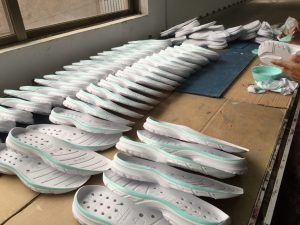 The EVA midsole is combined with the shoe outsole away from the main shoe assembly line. In a process called stock fitting, the outsole sub-assemblies are completed. Before stocking fitting, EVA parts may be washed to remove mold release and bonding surfaces may be buffed to cement adhesion.
EVA midsoles may be painted, plastic shanks fitted, rubber parts bonded, and logos added during stock fitting. The stock fitting line will have heat tunnels for drying primer and cement. This line will be very short, maybe 1/3rd the size of the main assembly line, but will have presses to ensure strong bonding of the sole parts.
The EVA midsole is combined with the shoe outsole away from the main shoe assembly line. In a process called stock fitting, the outsole sub-assemblies are completed. Before stocking fitting, EVA parts may be washed to remove mold release and bonding surfaces may be buffed to cement adhesion.
EVA midsoles may be painted, plastic shanks fitted, rubber parts bonded, and logos added during stock fitting. The stock fitting line will have heat tunnels for drying primer and cement. This line will be very short, maybe 1/3rd the size of the main assembly line, but will have presses to ensure strong bonding of the sole parts. 
